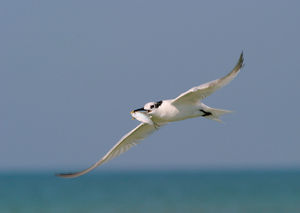Difference between revisions of "Pollution and sea birds"
| Line 8: | Line 8: | ||
Since the 1960's it is known that organochlorine pesticides can cause mortality, reduced fertility and eggshell thinning in terrestrial predatory birds. This led to the ban on use of many organochlorine pesticides in the 1970's in most western countries. Later effects of organochlorine pesticides have also been detected in sea birds. In 1965, the population of the dutch Sandwich Tern colony on the island of Griend declined, from 20.000 to 650 individuals, due to pesticide effluents form a chemical factory. | Since the 1960's it is known that organochlorine pesticides can cause mortality, reduced fertility and eggshell thinning in terrestrial predatory birds. This led to the ban on use of many organochlorine pesticides in the 1970's in most western countries. Later effects of organochlorine pesticides have also been detected in sea birds. In 1965, the population of the dutch Sandwich Tern colony on the island of Griend declined, from 20.000 to 650 individuals, due to pesticide effluents form a chemical factory. | ||
| − | An estimated 50.000 - 100.000 common guillemots died in the Irish Sea in 1969 with liver and kidney lesions similar to those caused by PCBs. However, it couldn't be proven that the guillemots indeed died by PCB poisoning.<ref>Clark, R,B., 1999. Marine pollution. Oxford University press, Fourth edition, pp 161</ref> | + | An estimated 50.000 - 100.000 common guillemots died in the Irish Sea in 1969 with liver and kidney lesions similar to those caused by PCBs. However, it couldn't be proven that the guillemots indeed died by PCB poisoning.<ref name=clark>Clark, R,B., 1999. Marine pollution. Oxford University press, Fourth edition, pp 161</ref> |
'''<u>Methylmercury</u>''' | '''<u>Methylmercury</u>''' | ||
| − | Sea birds can typically accumulate large amounts of mercury without negative effects. High values, which would be lethal for terrestrial birds were measured in the feathers of albatrosses, although they showed no signs of damage. As for marine mammals, sea birds can transform methylmercury in less toxic inorganic mercury. Furthermore the birds transport mercury to their growing feathers. In some sea birds up to 93% of the total mercury is stored in the feathers, where they cause no harm.<ref>Clark, R,B., 1999. Marine pollution. Oxford University press, Fourth edition, pp 161</ref> | + | Sea birds can typically accumulate large amounts of mercury without negative effects. High values, which would be lethal for terrestrial birds were measured in the feathers of albatrosses, although they showed no signs of damage. As for marine mammals, sea birds can transform methylmercury in less toxic inorganic mercury. Furthermore the birds transport mercury to their growing feathers. In some sea birds up to 93% of the total mercury is stored in the feathers, where they cause no harm.<ref name=clark>Clark, R,B., 1999. Marine pollution. Oxford University press, Fourth edition, pp 161</ref> |
Below you can find some links to Belgian case studies on ecotoxicology in marine mammals. | Below you can find some links to Belgian case studies on ecotoxicology in marine mammals. | ||
Revision as of 21:43, 8 July 2009
Like marine mammals, sea birds are in all marine ecosystems at the top (or very near the top) of the food chain. As such, they are particulary sensitive towards bioaccumulating substances. The best known bioaccumulating contaminants are organochlorine pesticides (like DDTs), polychlorinated biphenyls (PCBs) and methylmercury.
Organoclorine substances
Since the 1960's it is known that organochlorine pesticides can cause mortality, reduced fertility and eggshell thinning in terrestrial predatory birds. This led to the ban on use of many organochlorine pesticides in the 1970's in most western countries. Later effects of organochlorine pesticides have also been detected in sea birds. In 1965, the population of the dutch Sandwich Tern colony on the island of Griend declined, from 20.000 to 650 individuals, due to pesticide effluents form a chemical factory. An estimated 50.000 - 100.000 common guillemots died in the Irish Sea in 1969 with liver and kidney lesions similar to those caused by PCBs. However, it couldn't be proven that the guillemots indeed died by PCB poisoning.[1]
Methylmercury
Sea birds can typically accumulate large amounts of mercury without negative effects. High values, which would be lethal for terrestrial birds were measured in the feathers of albatrosses, although they showed no signs of damage. As for marine mammals, sea birds can transform methylmercury in less toxic inorganic mercury. Furthermore the birds transport mercury to their growing feathers. In some sea birds up to 93% of the total mercury is stored in the feathers, where they cause no harm.[1]
Below you can find some links to Belgian case studies on ecotoxicology in marine mammals.
Case studies
The relation between pollutants and disease in guillemots
Possible causes for breading failure in common terns
